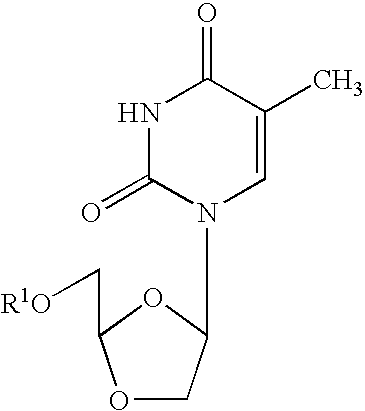Dioxolane thymine and combinations for use against 3TC/AZT resistant strains of HIV
a technology of dioxolane thymine and combinations, which is applied in the direction of biocide, heterocyclic compound active ingredients, group 5/15 element organic compounds, etc., can solve the problems of affecting the efficacy of abacavir, peripheral neuropathy is a major side effect, and the dose escalation of ddc is limited
- Summary
- Abstract
- Description
- Claims
- Application Information
AI Technical Summary
Benefits of technology
Problems solved by technology
Method used
Image
Examples
example 1
Evaluation of DOT Against 3TC and / or AZT Resistant Strains of HIV Cell-Based Assays in Human Lymphocytes
[0054]Cross-Resistance Studies: Human peripheral blood mononuclear (PBM) cells (obtained from Atlanta Red Cross) were isolated by Ficoll-Hypaque discontinuous gradient centrifugation from healthy seronegative donors. Cells were stimulated with phytohemagglutinin A (Difco, Sparks, Md.) for 2-3 days prior to use. M184V, L74V, 4XAZT, K65R, T215Y, T215Y / M184V viruses were obtained from Dr. John Mellor's laboratory (University of Pittsburgh, Pa.). K103N virus was obtained courtesy of prior DuPont Pharmaceuticals. Cross-resistance of beta-D-dioxolane-T (DOT) and other anti-HIV agents was evaluated against the above panel of mutated viruses. DOT was prepared according to the method set forth in Chu, et al., Tetrahedron Letters, Vol 32, No. 31, pp. 3791-3794 (1991). Infections were done in bulk for one hour, either with 100 TCID50 / 1 E7 cells for a flask (T25) assay or with 200 TCID50 / 6E5 ...
example 2
[0057]In related experiments, dioxolane thymine (DOT), beta-D-9-(5-hydroxymethyl-dioxolanyl-2-yl)-2,4-diamino-purine (DAPD) and beta-D-9-(5-hydroxymethyl-dioxolanyl-2-yl)guanine (DXG) were evaluated for their inhibitory effects against a number of 3TC and / or AZT resistant strains of HIV. The following Tables 2 and 3, set forth below, describe the HIV resistant strains genotypically (Table 2) and phenotypically (Table 3) which were used in the experiments to test activity.
[0058]
TABLE 2Genotype of HIV-1 Sensitive / Resistant Matched PairsPre-treatmentPost-treatmentMutations inIsolateIsolateReverse Transcriptase Gene(background)(resistant)of Post-treatment Isolate5705-05705-72D67N, K70R, K103N, I135L, M184V,K219E, R284K, C355F, R356K488-0488-101M41L, E122K, M184V, T215YH112-2C910-6M41L, D67N, K70R, T215Y, K219Q(other mutations not associated withAZT / R = V60I, K83R, H208Y, L239V,R356K and G359S)LAILAI M184VM184V
[0059]
TABLE 3Phenotype of HIV-1 Sensitive / Resistant Matched PairsVirusDrug (IC...
PUM
| Property | Measurement | Unit |
|---|---|---|
| concentrations | aaaaa | aaaaa |
| pH | aaaaa | aaaaa |
| pH | aaaaa | aaaaa |
Abstract
Description
Claims
Application Information
 Login to View More
Login to View More - R&D
- Intellectual Property
- Life Sciences
- Materials
- Tech Scout
- Unparalleled Data Quality
- Higher Quality Content
- 60% Fewer Hallucinations
Browse by: Latest US Patents, China's latest patents, Technical Efficacy Thesaurus, Application Domain, Technology Topic, Popular Technical Reports.
© 2025 PatSnap. All rights reserved.Legal|Privacy policy|Modern Slavery Act Transparency Statement|Sitemap|About US| Contact US: help@patsnap.com



